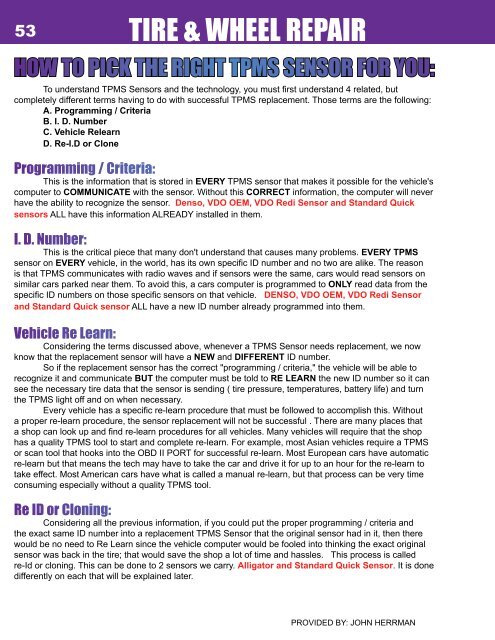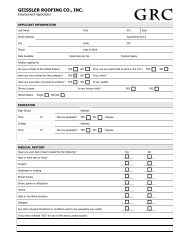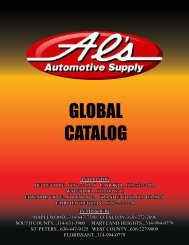You also want an ePaper? Increase the reach of your titles
YUMPU automatically turns print PDFs into web optimized ePapers that Google loves.
53<br />
<strong>TIRE</strong> & <strong>WHEEL</strong> <strong>REPAIR</strong><br />
HOW TO PICK THE RIGHT TPMS SENSOR FOR YOU:<br />
To understand TPMS Sensors and the technology, you must first understand 4 related, but<br />
completely different terms having to do with successful TPMS replacement. Those terms are the following:<br />
A. Programming / Criteria<br />
B. I. D. Number<br />
C. Vehicle Relearn<br />
D. Re-I.D or Clone<br />
Programming / Criteria:<br />
This is the information that is stored in EVERY TPMS sensor that makes it possible for the vehicle's<br />
computer to COMMUNICATE with the sensor. Without this CORRECT information, the computer will never<br />
have the ability to recognize the sensor. Denso, VDO OEM, VDO Redi Sensor and Standard Quick<br />
sensors ALL have this information ALREADY installed in them.<br />
I. D. Number:<br />
This is the critical piece that many don't understand that causes many problems. EVERY TPMS<br />
sensor on EVERY vehicle, in the world, has its own specific ID number and no two are alike. The reason<br />
is that TPMS communicates with radio waves and if sensors were the same, cars would read sensors on<br />
similar cars parked near them. To avoid this, a cars computer is programmed to ONLY read data from the<br />
specific ID numbers on those specific sensors on that vehicle. DENSO, VDO OEM, VDO Redi Sensor<br />
and Standard Quick sensor ALL have a new ID number already programmed into them.<br />
Vehicle Re Learn:<br />
Considering the terms discussed above, whenever a TPMS Sensor needs replacement, we now<br />
know that the replacement sensor will have a NEW and DIFFERENT ID number.<br />
So if the replacement sensor has the correct "programming / criteria," the vehicle will be able to<br />
recognize it and communicate BUT the computer must be told to RE LEARN the new ID number so it can<br />
see the necessary tire data that the sensor is sending ( tire pressure, temperatures, battery life) and turn<br />
the TPMS light off and on when necessary.<br />
Every vehicle has a specific re-learn procedure that must be followed to accomplish this. Without<br />
a proper re-learn procedure, the sensor replacement will not be successful . There are many places that<br />
a shop can look up and find re-learn procedures for all vehicles. Many vehicles will require that the shop<br />
has a quality TPMS tool to start and complete re-learn. For example, most Asian vehicles require a TPMS<br />
or scan tool that hooks into the OBD II PORT for successful re-learn. Most European cars have automatic<br />
re-learn but that means the tech may have to take the car and drive it for up to an hour for the re-learn to<br />
take effect. Most American cars have what is called a manual re-learn, but that process can be very time<br />
consuming especially without a quality TPMS tool.<br />
Re ID or Cloning:<br />
Considering all the previous information, if you could put the proper programming / criteria and<br />
the exact same ID number into a replacement TPMS Sensor that the original sensor had in it, then there<br />
would be no need to Re Learn since the vehicle computer would be fooled into thinking the exact original<br />
sensor was back in the tire; that would save the shop a lot of time and hassles. This process is called<br />
re-Id or cloning. This can be done to 2 sensors we carry. Alligator and Standard Quick Sensor. It is done<br />
differently on each that will be explained later.<br />
PROVIDED BY: JOHN HERRMAN





